 In a blog in October 2024, we looked at global uncertainty and how it can be captured in a World Uncertainty Index. The blog stated that ‘We continue to live through incredibly turbulent times. In the past decade or so we have experienced a global financial crisis, a global health emergency, seen the UK’s departure from the European Union, and witnessed increasing levels of geopolitical tension and conflict’.
In a blog in October 2024, we looked at global uncertainty and how it can be captured in a World Uncertainty Index. The blog stated that ‘We continue to live through incredibly turbulent times. In the past decade or so we have experienced a global financial crisis, a global health emergency, seen the UK’s departure from the European Union, and witnessed increasing levels of geopolitical tension and conflict’.
Since then, Donald Trump has been elected for a second term and has introduced sweeping tariffs. What is more, the tariffs announced on so-called ‘Liberation Day‘ have not remained fixed, but have fluctuated with negotiations and threatened retaliation. The resulting uncertainty makes it very hard for businesses to plan and many have been unwilling to commit to investment decisions. The uncertainty has been compounded by geopolitical events, such as the continuing war in Ukraine, the war in Gaza and the June 13 Israeli attack on Iran.
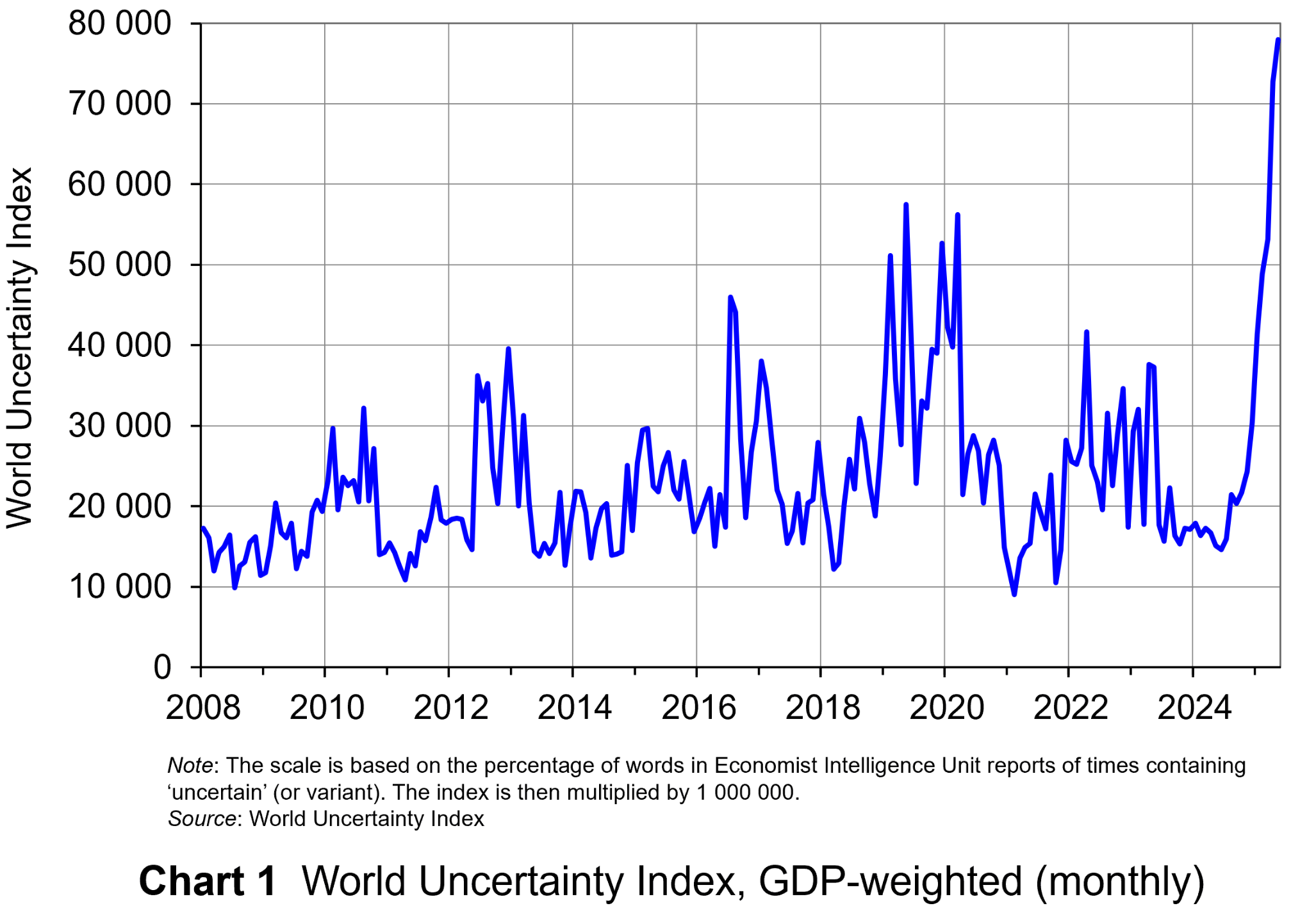 The World Uncertainty Index (WUI) tracks uncertainty around the world by applying a form of text mining known as ‘term frequency’ to the country reports produced by the Economist Intelligence Unit (EIU). The words searched for are ‘uncertain’, ‘uncertainty’ and ‘uncertainties’ and the number of times they occur as percentage of the total words is recorded. To produce the WUI this figure is then multiplied by 1m. A higher WUI number indicates a greater level of uncertainty.
The World Uncertainty Index (WUI) tracks uncertainty around the world by applying a form of text mining known as ‘term frequency’ to the country reports produced by the Economist Intelligence Unit (EIU). The words searched for are ‘uncertain’, ‘uncertainty’ and ‘uncertainties’ and the number of times they occur as percentage of the total words is recorded. To produce the WUI this figure is then multiplied by 1m. A higher WUI number indicates a greater level of uncertainty.
The monthly global average WUI is shown in Chart 1 (click here for a PowerPoint). It is based on 71 countries. Since 2008 the WUI has averaged a little over 23 000: i.e. 2.3 per cent of the text in EIU reports contains the word ‘uncertainty’ or a close variant. In May 2025, it was almost 79 000 – the highest since the index was first complied in 2008. The previous highest was in March 2020, at the start of the COVID-19 outbreak, when the index rose to just over 56 000.
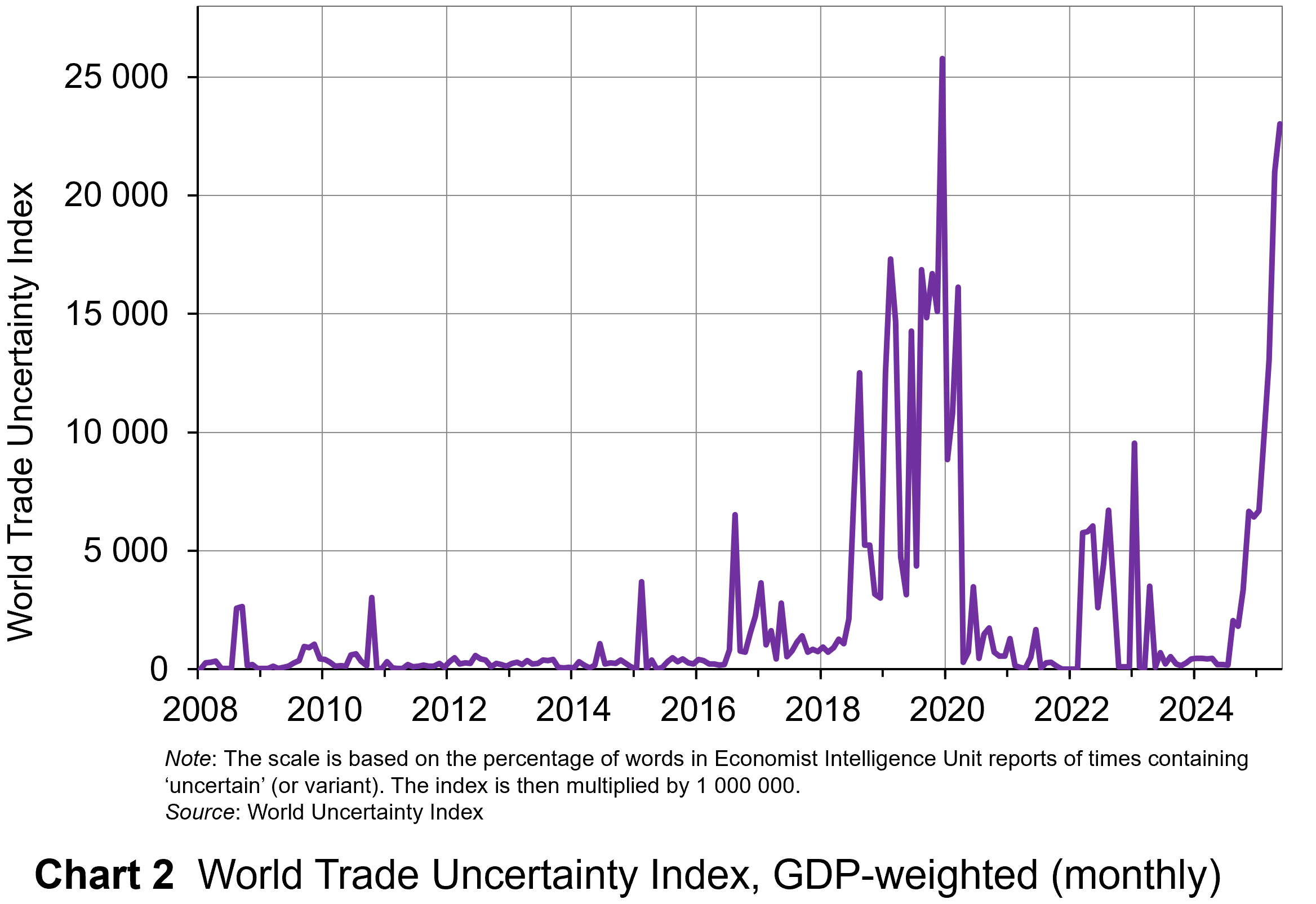 The second chart shows the World Trade Uncertainty Index (WTUI), published on the same site as the WUI (click here for a PowerPoint). The method adopted in its construction therefore mirrors that for the WUI but counts the number of times in EIU country reports ‘uncertainty’ is mentioned within proximity to a word related to trade, such as ‘protectionism’, ‘NAFTA’, ‘tariff’, ‘trade’, ‘UNCTAD’ or ‘WTO.’
The second chart shows the World Trade Uncertainty Index (WTUI), published on the same site as the WUI (click here for a PowerPoint). The method adopted in its construction therefore mirrors that for the WUI but counts the number of times in EIU country reports ‘uncertainty’ is mentioned within proximity to a word related to trade, such as ‘protectionism’, ‘NAFTA’, ‘tariff’, ‘trade’, ‘UNCTAD’ or ‘WTO.’
The chart shows that in May 2025, the WTUI had risen to just over 23 000 – the second highest since December 2019, when President Trump imposed a new round of tariffs on Chinese imports and announced that he would restore steel tariffs on Brazil and Argentina. Since 2008, the WTUI has averaged just 2228.
It remains to be seen whether more stability in trade relations and geopolitics will allow WUI and WUTI to decline once more, or whether greater instability will simply lead to greater uncertainty, with damaging consequences for investment and also for consumption and employment.
Articles
Uncertainty Indices
Questions
- Explain what is meant by ‘text mining’. What are its strengths and weaknesses in assessing business, consumer and trade uncertainty?
- Explain how the UK Monthly EPU Index is derived.
- Why has uncertainty increased so dramatically since the start of 2025?
- Compare indices based on text mining with confidence indices.
- Plot consumer and business/industry confidence indicators for the past 24 months, using EC data. Do they correspond with the WUI?
- How may uncertainty affect consumers’ decisions?
 Economic growth is closely linked to investment. In the short term, there is a demand-side effect: higher investment, by increasing aggregate demand, creates a multiplier effect. GDP rises and unemployment falls. Over the longer term, higher net investment causes a supply-side effect: industrial capacity and potential output rise. This will be from both the greater quantity of capital and, if new investment incorporates superior technology, from a greater productivity of capital.
Economic growth is closely linked to investment. In the short term, there is a demand-side effect: higher investment, by increasing aggregate demand, creates a multiplier effect. GDP rises and unemployment falls. Over the longer term, higher net investment causes a supply-side effect: industrial capacity and potential output rise. This will be from both the greater quantity of capital and, if new investment incorporates superior technology, from a greater productivity of capital.
One of the biggest determinants of investment is certainty about the future: certainty allows businesses to plan investment. Uncertainty, by contrast, is likely to dampen investment. Investment is for future output and if the future is unknown, why undertake costly investment? After all, the cost of investment is generally recouped over several months or year, not immediately. Uncertainty thus increases the risks of investment.
 There is currently great uncertainty in the USA and its trading partners. The frequent changes in policy by President Trump are causing a fall in confidence and consequently a fall in investment. The past few weeks have seen large cuts in US government expenditure as his administration seeks to dismantle the current structure of government. The businesses supplying federal agencies thus face great uncertainty about future contracts. Laid-off workers will be forced to cut their spending, which will have knock-on effect on business, who will cut employment and investment as the multiplier and accelerator work through.
There is currently great uncertainty in the USA and its trading partners. The frequent changes in policy by President Trump are causing a fall in confidence and consequently a fall in investment. The past few weeks have seen large cuts in US government expenditure as his administration seeks to dismantle the current structure of government. The businesses supplying federal agencies thus face great uncertainty about future contracts. Laid-off workers will be forced to cut their spending, which will have knock-on effect on business, who will cut employment and investment as the multiplier and accelerator work through.
There are also worries that the economic chaos caused by President Trump’s frequent policy changes will cause inflation to rise. Higher inflation will prompt the Federal Reserve to raise interest rates. This, in turn, will increase the cost of borrowing for investment.
Tariff uncertainty
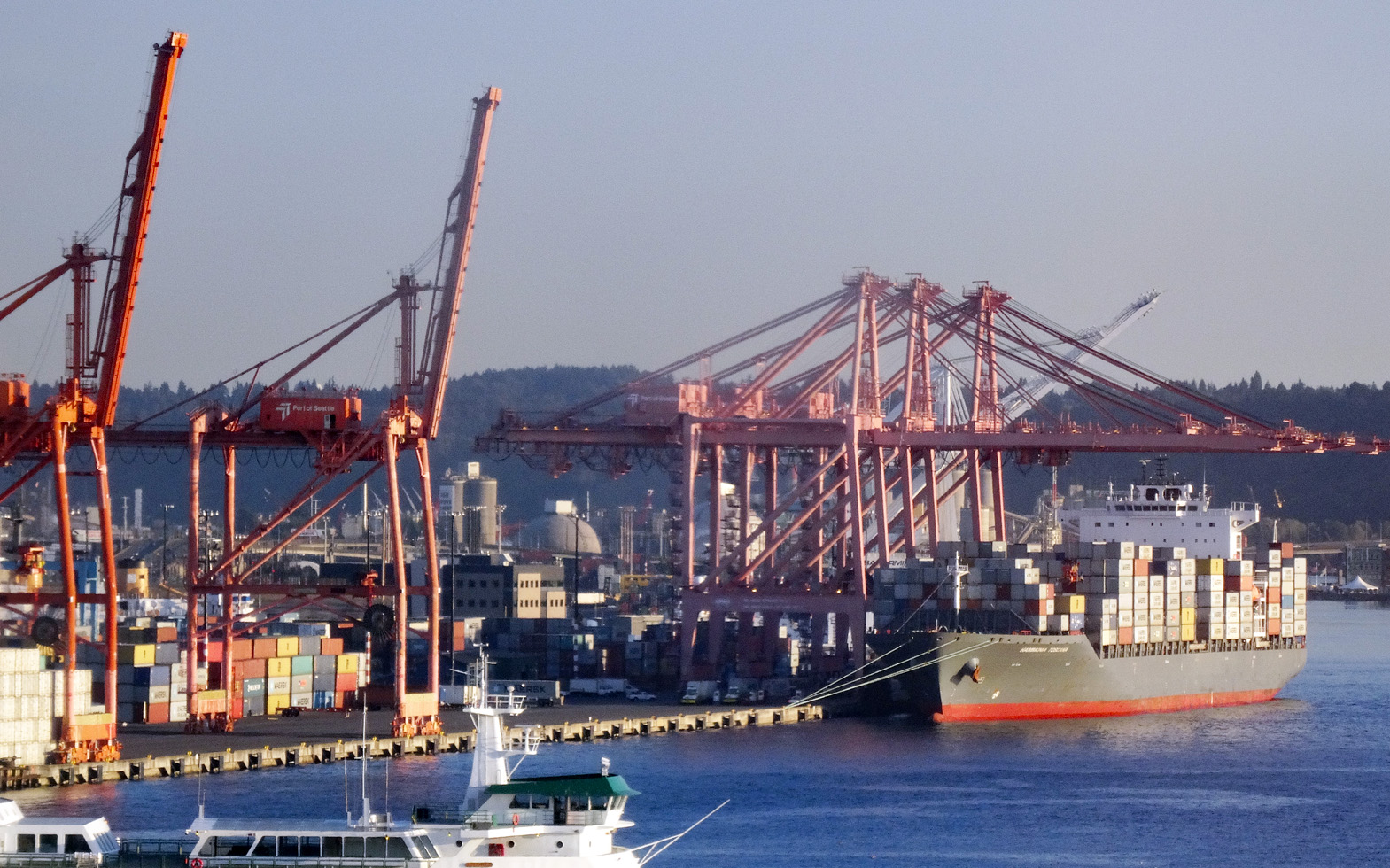 Perhaps the biggest uncertainty for business concerns the imposition of tariffs. Many US businesses rely on imports of raw materials, components, equipment, etc. Imposing tariffs on imports raises business costs. But this will vary from firm to firm, depending on the proportion of their inputs that are imported. And even when the inputs are from other US companies, those companies may rely on imports and thus be forced to raise prices to their customers. And if, in retaliation, other countries impose tariffs on US goods, this will affect US exporters and discourage them from investing.
Perhaps the biggest uncertainty for business concerns the imposition of tariffs. Many US businesses rely on imports of raw materials, components, equipment, etc. Imposing tariffs on imports raises business costs. But this will vary from firm to firm, depending on the proportion of their inputs that are imported. And even when the inputs are from other US companies, those companies may rely on imports and thus be forced to raise prices to their customers. And if, in retaliation, other countries impose tariffs on US goods, this will affect US exporters and discourage them from investing.
For many multinational companies, whether based in the USA or elsewhere, supply chains involve many countries. New tariffs will force them to rethink which suppliers to use and where to locate production. The resulting uncertainty can cause them to delay or cancel investments.
Uncertainty has also been caused by the frequent changes in the planned level of tariffs. With the Trump administration using tariffs as a threat to get trading partners to change policy, the threatened tariff rates have varied depending on how trading partners have responded. There has also been uncertainty on just how the tariff policy will be implemented, making it more difficult for businesses to estimate the effect on them.
Then there are serious issues for the longer term. Other countries will be less willing to sign trade deals with the USA if they will not be honoured. Countries may increasingly look to diverting trade from the USA to other countries.
Video
Articles
- Trump’s erratic trade policies are baffling businesses, threatening investment and economic growth
Associated Press, Paul Wiseman, Anne D’innocenzio and Mae Anderson (6/3/25)
- The world is beginning to tire of Trump’s whiplash leadership
CNN, Stephen Collinson (6/3/25)
- US stocks slide and Nasdaq enters correction as chaos over Trump’s tariffs intensifies
CNN, John Towfighi (6/3/25)
- Trump’s Tariffs And Trade: Uncertainty, Chaos Or Brilliance?
Forbes, Mike Patton (6/3/25)
- How Trump’s second term might affect the market and your finances
The Conversation, Art Durnev (4/3/25)
- US corporate bond investors cautiously navigate trade war uncertainty
Reuters, Matt Tracy (6/3/25)
 This week in Trumponomics: Playing chicken with markets
This week in Trumponomics: Playing chicken with marketsYahoo Finance, Rick Newman (8/3/25)
- Measuring fear: What the VIX reveals about market uncertainty
The FRED Blog, Aakash Kalyani (13/2/25)
- Trump shrugs off stock market slump, but economic warning signs loom
The Conversation, Conor O’Kane (17/3/25)
Data
Questions
- Find out what tariffs have been proposed, imposed and changed since Donald Trump came to office on 20 January 2025.
- In what scenario might US investment be stimulated by Donald Trump’s policies?
- What countries’ economies have gained or are set to gain from Donald Trump’s policies?
- What is the USMCA agreement? Do Donald Trump’s policies break this agreement?
- Find out and explain what has happened to the US stock market since January 2025. How do share prices affect business investment?
- Which sector’s shares have risen and which have fallen?
- Using the Data link above, find out what has been happening to the US Policy Uncertainty Index since Donald Trump was elected and explain particular spikes in the index. Is this mirrored in the global Policy Uncertainty Index?
- Are changes in the Policy Uncertainty Index mirrored in the World Uncertainty Index (WUI) and the CBOE Volatility Index: VIX?
 Africa’s energy transition is at a pivotal moment. While the continent boasts abundant renewable energy resources, its electricity generation and distribution remain fragmented. Cross-border electricity trade has emerged as a potential game-changer, fostering energy security, reducing costs, and accelerating the adoption of renewables. However, is Africa fully leveraging this opportunity?
Africa’s energy transition is at a pivotal moment. While the continent boasts abundant renewable energy resources, its electricity generation and distribution remain fragmented. Cross-border electricity trade has emerged as a potential game-changer, fostering energy security, reducing costs, and accelerating the adoption of renewables. However, is Africa fully leveraging this opportunity?
In a forthcoming paper in the Energy & Environment journal, I join forces with my colleagues Mercy Adaji and Bereket Kebede to argue that the answer to this question is no. Our study examines the impact of cross-border electricity trade in renewable electricity generation across 21 African countries over a 24-year period (1996–2020). Our findings indicate that a 1% increase in electricity trade significantly raises the share of renewables in total electricity output by approximately 0.05%. This underscores the crucial role of regional integration in advancing Africa’s clean energy goals, aligning with previous studies (e.g., Boz et al., 2021; Song et al., 2022, linked below) that highlight how electricity market integration promotes renewable energy investments by stabilising supply and mitigating intermittency risks.
Despite these advantages, cross-border electricity trade remains significantly underutilised due to regulatory barriers, inadequate infrastructure, and governance challenges.
 Net electricity-importing countries tend to benefit more from trade, while net-exporting nations, particularly those reliant on fossil fuels, exhibit weaker positive impacts. Without targeted policies (such as carbon pricing and green subsidies) trade disparities may persist, slowing the transition to clean energy.
Net electricity-importing countries tend to benefit more from trade, while net-exporting nations, particularly those reliant on fossil fuels, exhibit weaker positive impacts. Without targeted policies (such as carbon pricing and green subsidies) trade disparities may persist, slowing the transition to clean energy.
Moreover, our results highlight the pivotal role of governance in fostering a robust electricity market. This is neither surprising nor new – quality of governance matters over the long term in all aspects of economic activity. Agostini et al. (2019), for instance, show that well-structured regulations and strategic investments in interconnections enhance the effectiveness of cross-border electricity trade. Transparent regulatory frameworks, expanded grid interconnections, and harmonised energy policies can significantly boost the impact of regional electricity trade.
By strengthening collaboration, African nations can mitigate energy poverty, enhance supply reliability, and accelerate the shift toward a greener future.
To capitalise fully on cross-border electricity trade, African policymakers must prioritise regional energy integration, invest in infrastructure and implement incentives to spur renewable energy expansion. With the right policies and co-operative strategies, Africa can harness its vast renewable potential and achieve a more sustainable, energy-secure future.
Articles
- Powering Africa’s sustainable future: The role of cross-border electricity trade on renewable electricity generation
Energy & Environment, Mercy Adaji, Nicholas Vasilakos and Bereket Kebede (17/2/25)
- A surplus based framework for cross-border electricity trade in South America
Energy Policy, Claudio A Agostini, Andrés M Guzmán, Shahriyar Nasirov and Carlos Silva (1/2/19)
- The effects of cross-border electricity trade on power production from different energy sources
The Electricity Journal, Deniz Ege Boz, Baris Sanli and M Hakan Berument (20/4/21)
- Energy market integration and renewable energy development: Evidence from the European Union countries
Journal of Environmental Management, Malin Song, Haitao Xu, Zhiyang Shen and Xiongfeng Pan (5/6/22)
Questions
- How does electricity trade help mitigate the intermittency challenges of renewable energy, and what mechanisms could further enhance its effectiveness?
- The study highlights governance quality as a crucial factor in the success of cross-border electricity trade. What governance-related challenges do African countries face in implementing a unified electricity market, and how can policymakers address them to maximize trade benefits?
- Our results show that net electricity-importing countries tend to gain more from trade than net-exporting ones, particularly those relying on fossil fuels. What policy measures can be introduced to ensure that net-exporting countries also benefit from electricity trade while advancing renewable energy integration?
- What are the most critical infrastructure and policy gaps that hinder the growth of cross-border electricity trade in Africa, and how can these be overcome to facilitate a more sustainable energy transition?
 Tesla sales have fallen dramatically recently. In Europe they were down 47.7% in January 2025 compared with January 2024. In Spain the figure was 75.4%, in France 63.4%, in Germany 59.5%, in Sweden 44.3%, in Norway 37.9%, in the UK 18.2% and in Italy 13.4%. And it was not just Europe. In Australia the figure was 33.2%, in China 15.5% and in California 11.6%. Meanwhile, Tesla’s share price has fallen from a peak of $480 on 17 December 2024 to $338 on 21 February 2025, although that compares with $192 in February 2024.
Tesla sales have fallen dramatically recently. In Europe they were down 47.7% in January 2025 compared with January 2024. In Spain the figure was 75.4%, in France 63.4%, in Germany 59.5%, in Sweden 44.3%, in Norway 37.9%, in the UK 18.2% and in Italy 13.4%. And it was not just Europe. In Australia the figure was 33.2%, in China 15.5% and in California 11.6%. Meanwhile, Tesla’s share price has fallen from a peak of $480 on 17 December 2024 to $338 on 21 February 2025, although that compares with $192 in February 2024.
So why have Tesla sales fallen? It’s not because of a rise in price (a movement up the demand curve); indeed, Tesla cut its prices in 2024. Part of the reason is on the supply side. In several countries, stocks of Teslas are low. Some consumers who would have bought have had to wait. However, the main reason is that the demand curve has shifted to the left. So why has this happened?
A reaction to Elon Musk?
 One explanation is a growing unpopularity of Elon Musk among many potential purchasers of electric vehicles (EVs). People are more likely to buy an EV if they are environmentally concerned and thus more likely to be Green voters or on the political left and centre. Elon Musk, by supporting Donald Trump and now a major player in the Trump administration, is seen as having a very different perspective. Trump’s mantra of ‘drill, baby drill’ and his announced withdrawal from the Paris agreement and the interventions of Trump, Vance and Musk in European politics have alienated many potential purchasers of new Teslas. Elon Musk has been a vocal supporter of the right-wing Alternative for Germany (AfD) party, describing the party as the ‘last spark of hope for this country’ (see BBC article linked below).
One explanation is a growing unpopularity of Elon Musk among many potential purchasers of electric vehicles (EVs). People are more likely to buy an EV if they are environmentally concerned and thus more likely to be Green voters or on the political left and centre. Elon Musk, by supporting Donald Trump and now a major player in the Trump administration, is seen as having a very different perspective. Trump’s mantra of ‘drill, baby drill’ and his announced withdrawal from the Paris agreement and the interventions of Trump, Vance and Musk in European politics have alienated many potential purchasers of new Teslas. Elon Musk has been a vocal supporter of the right-wing Alternative for Germany (AfD) party, describing the party as the ‘last spark of hope for this country’ (see BBC article linked below).
There has been outspoken criticism of Musk in the media and the Financial Times reports existing owners of Teslas, who are keen to distance themselves from Musk, ordering stickers for their cars which read ‘I bought this before Elon went crazy’. In a survey by Electrifying.com, 59% of UK potential EV buyers stated that Musk’s reputation put them off buying a Tesla.
Other reasons for a leftward shift in the demand for Teslas
But is it just the ‘Musk factor’ that has caused a fall in demand? It is useful to look at the general determinants of demand and see how each might have affected the demand for Teslas.
The price, number, quality and availability of substitutes Tesla faces competition, not only from long-established car companies, such as Ford, VW, Volvo/Polestar, Seat/Cupra and Toyota, moving into the EV market, but also from Chinese companies, such as BYD and NIO. These are competing in all segments of the EV market and competition is constantly increasing. Some of these companies are competing strongly with Tesla in terms of price; others in terms of quality, style and imaginative features. The sheer number of competitor models has grown rapidly. For some consumers, Teslas now seem dated compared with competitors.
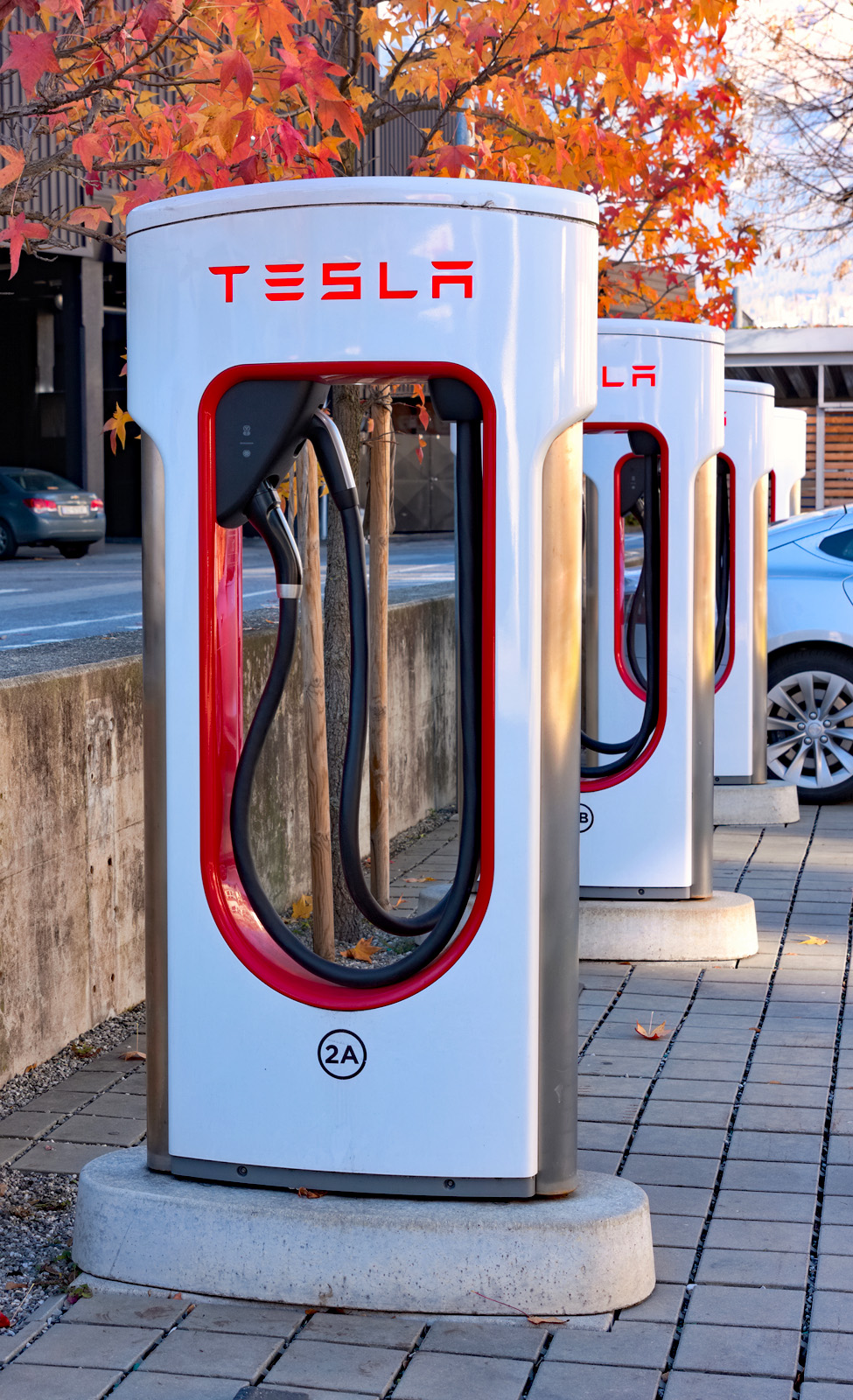 The price and availability of complements. The most relevant complement here is electrical charging points. As Teslas can be charged using both Tesla and non-Tesla charging points, there is no problem of compatibility. The main issue is the general one for all EVs and that is how to achieve range conveniently. The fewer the charging points and more widely disbursed they are, the more people will be put off buying an EV, especially if they are not able to have a charging point at home. Clearly, the greater the range of a model (i.e. the distance that can be travelled on a full battery), the less the problem. Teslas have a relatively high range compared with most (but not all) other makes and so this is unlikely to account for the recent fall in demand, especially relative to other makes.
The price and availability of complements. The most relevant complement here is electrical charging points. As Teslas can be charged using both Tesla and non-Tesla charging points, there is no problem of compatibility. The main issue is the general one for all EVs and that is how to achieve range conveniently. The fewer the charging points and more widely disbursed they are, the more people will be put off buying an EV, especially if they are not able to have a charging point at home. Clearly, the greater the range of a model (i.e. the distance that can be travelled on a full battery), the less the problem. Teslas have a relatively high range compared with most (but not all) other makes and so this is unlikely to account for the recent fall in demand, especially relative to other makes.
Expectations. The current best-selling Tesla EV is the Model Y. This model is being relaunched in a very different version, as are other Tesla models. Consumers may prefer to wait until the new models become available. In the meantime, demand would be expected to fall.
Conclusions
As we have seen, there have been a number of factors adversely affecting Tesla sales. Growing competition is a major factor. Nevertheless, the increasing gap politically between Elon Musk and many EV consumers is a major factor – a factor that is likely to grow in significance if Musk’s role in the Trump administration continues to be one of hostility towards the liberal establishment and in favour of the hard right.
Articles
- Tesla’s sales plummet across Europe
Financial Times, Patricia Nilsson, Laura Pitel and Kana Inagaki (6/2/25)
- Tesla sales plummet nearly 50% in Europe – what’s behind the drop?
motor1.com, Brian Potter (5/2/25)
- Elon Musk is putting buyers off Tesla, survey reveals
Electrifying.com, Tom Barnard (27/1/25)
- ‘I felt nothing but disgust’: Tesla owners vent their anger at Elon Musk
The Guardian, Ashifa Kassam (25/2/25)
- Elon Musk is putting consumers off buying Tesla cars with his behaviour, research suggests
indy100, Ellie Abraham (27/1/25)
- Are Elon Musk’s politics costing Tesla sales?
CNN, Chris Isidore (18/2/25)
- Is Tesla’s sales slump down to Elon Musk?
The Conversation, James Obiegbu and Gretchen Larsen (11/2/25)
- Tesla Sales Are Tanking Across The World
InsideEVs, Patrick George (8/2/25)
- Is Elon Musk steering Tesla into a brand crisis?
The Drum, Audrey Kemp (29/1/25)
- Why are Tesla sales down? Elon Musk’s politics may be to blame
The Standard, Saqib Shah (18/2/25)
- Tesla sales slump on ageing line up, competition
Argus, Chris Welch (12/2/25)
- Trends in electric vehicle charging, Global EV Outlook 2024
International Energy Agency (23/4/24)
- What Are Tesla’s (TSLA) Main Competitors?
Investopedia, Peter Gratton (1/2/25)
- Europe leaders criticise Musk attacks
BBC News, Paul Kirby & Laura Gozzi (7/1/25)
- German far-right leader Weidel woke up to missed call from Elon Musk
Yahoo News, dpa international (24/2/25)
- ‘Major brand worries’: Just how toxic is Elon Musk for Tesla?
The Guardian, Dan Milmo and Jasper Jolly (8/3/25)
Questions
- Why have BYD EV sales risen so rapidly?
- If people feel strongly about a product on political or ethical grounds, how is that likely to affect their price elasticity of demand for the product?
- Find out how Tesla shareholders are reacting to Elon Musk’s behaviour.
- Find out how Tesla sales have changed among (a) Democratic voters and (b) Republican voters in the USA. How would you explain these trends?
- Identify some products that you would or would not buy on ethical grounds. How carefully have you researched these products?
 The market for crude oil is usually a volatile one. Indeed, in the last few months, the market has seen prices rise and fall due to various supply and demand influences. Crude oil is coined the ‘King of Commodities’ due to the impact it has on consumers, producers and both the micro and macro economy. The price of crude oil affects everything from the cost of producing plastics, transportation, and food at the supermarket.
The market for crude oil is usually a volatile one. Indeed, in the last few months, the market has seen prices rise and fall due to various supply and demand influences. Crude oil is coined the ‘King of Commodities’ due to the impact it has on consumers, producers and both the micro and macro economy. The price of crude oil affects everything from the cost of producing plastics, transportation, and food at the supermarket.
This makes the market for crude oil an economic powerhouse which is closely watched by businesses, traders, and governments. To gain a full understanding of the movements in this market, it is important to identify how demand and supply affect the price of crude oil.
What influences the demand and supply of crude oil?
The law of demand and supply states that if demand increases, prices will rise, and if supply increases, prices will fall. This is exactly what happens in the market for crude oil. The consumer side of the market consists of various companies and hundreds of millions of people. The producer side of the market is made up of oil-producing countries. Collectively, both consumers and producers influence the market price.
However, the demand and supply of crude oil, and therefore the price, is also affected by global economic conditions and geopolitical tensions. What happens in the world impacts the price of oil, especially since a large proportion of the world’s biggest oil producers are in politically unstable areas.
 Over the past five years, global events have had a major impact on the price of oil. The economic conditions created by the impact of the COVID pandemic saw prices plummet from around $55 per barrel just before the pandemic in February 2020 to around $15 per barrel in April 2020. By mid-2021 they had recovered to around $75 per barrel. Then, in the aftermath of Russia’s invasion of Ukraine in February 2022, the price surged to reach $133 in June 2022. More recently, geopolitical tensions in the Middle East and concerns about China’s economic outlook have intensified concerns about the future direction of the market. (Click here for a PowerPoint of the chart.)
Over the past five years, global events have had a major impact on the price of oil. The economic conditions created by the impact of the COVID pandemic saw prices plummet from around $55 per barrel just before the pandemic in February 2020 to around $15 per barrel in April 2020. By mid-2021 they had recovered to around $75 per barrel. Then, in the aftermath of Russia’s invasion of Ukraine in February 2022, the price surged to reach $133 in June 2022. More recently, geopolitical tensions in the Middle East and concerns about China’s economic outlook have intensified concerns about the future direction of the market. (Click here for a PowerPoint of the chart.)
Geopolitical tensions
In the first week of October 2024, the price of crude oil rose by almost 10% to around $78 per barrel as the conflict in the Middle East intensified. It unfortunately comes at a time when many countries are starting to recover from the rise in oil prices caused by the pandemic and the war in Ukraine. Any increase in prices will affect the price that consumers pay to fill up their vehicles with fuel, just when prices of diesel and petrol had reached their lowest level for three years.
 The Governor of the Bank of England, Andrew Bailey, has said that the Bank is monitoring developments in the Middle East ‘extremely closely’, as the conflict has the potential to have serious impacts in the UK. The Bank of England will therefore be watching for any movement in oil prices that could fuel inflation.
The Governor of the Bank of England, Andrew Bailey, has said that the Bank is monitoring developments in the Middle East ‘extremely closely’, as the conflict has the potential to have serious impacts in the UK. The Bank of England will therefore be watching for any movement in oil prices that could fuel inflation.
The main concerns stem from further escalation in the conflict between Israel and the Iran-backed armed group, Hezbollah, in Lebanon. If Israel decides to attack Iran’s oil sector, this is likely to cause a sharp rise in the price of oil. Iran is the world’s seventh largest oil exporter and exports over half of its production to China. If the oilfields of a medium-sized supplier, like Iran, were attacked, this could threaten general inflation in the UK, which could in turn influence any decision by the Bank of England to lower interest rates next month.
Supply deficits
This week (2nd week of October 2024) saw the price of crude oil surge above $81 per barrel to hit its highest level since August. This rise means that prices increased by 12% in a week. However, this surge in price also means that prices rose by almost 21% between the start September and the start of October alone. Yet it was only in early September when crude oil hit a year-to-date low, highlighting the volatility in the market.
As the Middle-East war enters a new and more energy-related phase, the loss of Iranian oil would leave the market in a supply deficit. The law of supply implies that such a deficit would lead to an increase in prices. This also comes at a time when the US Strategic Petroleum Reserve has also been depleted, causing further concerns about global oil supply.
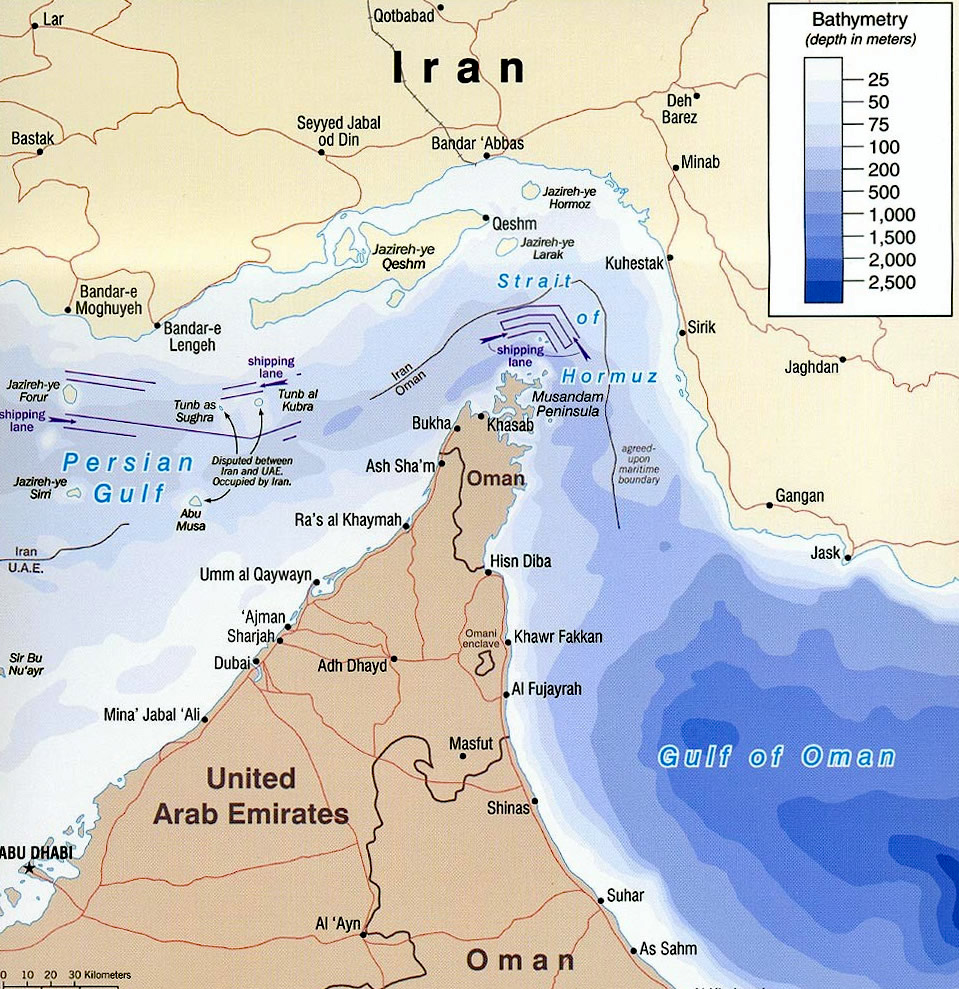 However, the biggest and most significant impact would be a disruption to flows through the Strait of Hormuz. This is a relatively narrow channel at the east end of the Persian Gulf through which a huge amount of oil tanker traffic passes – about a third of total seaborne-traded oil. It is therefore known as the world’s most important oil transit chokepoint. The risk that escalation could block the Strait of Hormuz could technically see a halt in about a fifth of the world’s oil supply. This would include exports from big Gulf producers, including Saudi Arabia, UAE, Kuwait and Iraq. In a worst-case scenario of a full closure of the Strait, a barrel of oil could very quickly rise to well above $100.
However, the biggest and most significant impact would be a disruption to flows through the Strait of Hormuz. This is a relatively narrow channel at the east end of the Persian Gulf through which a huge amount of oil tanker traffic passes – about a third of total seaborne-traded oil. It is therefore known as the world’s most important oil transit chokepoint. The risk that escalation could block the Strait of Hormuz could technically see a halt in about a fifth of the world’s oil supply. This would include exports from big Gulf producers, including Saudi Arabia, UAE, Kuwait and Iraq. In a worst-case scenario of a full closure of the Strait, a barrel of oil could very quickly rise to well above $100.
Disruption to shipments would also lead to higher gas prices and therefore lead to a rise in household gas and electricity bills. As with oil, gas prices filter down supply chains, affecting the cost of virtually all goods, resulting in a further rise in the cost of living. With energy bills in the UK having already risen by 10% for this winter, an escalation to the conflict could see prices rise further still.
China’s economic outlook

Despite the concern for the future supply of oil, there is also a need to consider how the demand for oil could impact price changes in the market. The price of oil declined on 14 October 2024 in light of concerns over China’s struggling economy. As China is the world’s largest importer of crude oil, there are emerging fears about the potential limits on fuel demand. This fall in price reversed increases made the previous week as investors become concerned about worsening deflationary pressures in China.
Any reduced demand from China could indicate an oversupply of crude oil and therefore potential price declines. Official data from China reveal a sharp year-on-year drop in the producer price index of 2.8% – the fastest decline in six months. These disappointing results have stirred uncertainty about the Chinese government’s economic stimulus plans. Prices could fall further if there are continuing doubts about the government’s ability to implement effective fiscal measures to promote consumer spending and, in turn, economic growth.
As a result of the 2% price fall in oil prices on 14 October, OPEC (the Organization of the Petroleum Exporting Countries) has lowered its 2024 and 2025 global oil demand growth. This negative news outweighed market concerns over the possibility that an Israeli response to Iran’s missile attack could disrupt oil production.
What is the future for oil prices?
 It is expected that the market for oil will remain a volatile one. Indeed, the current uncertainties around the globe only highlight this. It is never a simple task to predict what will happen in a market that is influenced by so many global factors, and the current global landscape only adds to the complexity.
It is expected that the market for oil will remain a volatile one. Indeed, the current uncertainties around the globe only highlight this. It is never a simple task to predict what will happen in a market that is influenced by so many global factors, and the current global landscape only adds to the complexity.
There’s a wide spectrum of predictions about what could come next in the market for crude oil. Given the changes in the first two weeks of October alone, supply and demand factors from separate parts of the globe have made the future of oil prices particularly uncertain. Callum Macpherson, head of commodities at Investec, stated in early October that ‘there is really no way of telling where we will be this time next week’ (see the first BBC News article linked below).
Despite the predominately negative outlook, this is all based on potential scenarios. Caroline Bain, chief commodities economist at Capital Economics suggests that if the ‘worst-case scenario’ of further escalation in the Middle East conflict does not materialise, oil prices are likely to ‘ease back quite quickly’. Even if Iran’s supplies were disrupted, China could turn to Russia for its oil. Bain says that there is ‘more than enough capacity’ globally to cover the gap if Iranian production is lost. However, this does then raise the question of where the loyalty of Saudi Arabia, the world’s second largest oil producer, lies and whether it will increase or restrict further production.
What is certain is that the market for crude oil will continue to be a market that is closely observed. It doesn’t take much change in global activity for prices to move. Therefore, in the current political and macroeconomic environment, the coming weeks and months will be critical in determining oil prices and, in turn, their economic effects.
Articles
- How worried should I be about rising oil prices?
BBC News, Michael Race (4/10/24)
- Interest rates could fall more quickly, hints Bank
BBC News, Dearbail Jordan (3/10/24)
- Oil Prices Eye $100 A Barrel As War Risk Premium Returns
FX Empire, Phil Carr (8/10/24)
- Crude oil futures reverse previous gains following disappointing economic data from China
London Loves Business, Hamza Zraimek (14/10/24)
- Oil falls 2% as OPEC cuts oil demand growth view, China concerns
Reuters, Arathy Somasekhar (14/10/24)
- Could war in the Gulf push oil to $100 a barrel?
The Economist (7/10/24)
- The Commodities Feed: Oil remains volatile
ING Think, Ewa Manthey and Warren Patterson (8/10/24)
- Who and what is driving oil price volatility
FT Alphaville, George Steer (9/10/24)
- Brent crude surges above $80 as conflict and storm spark supply fears
Financial Times, Rafe Uddin and Jamie Smyth (7/10/24)
Questions
- Use a demand and supply diagram to illustrate what has happened to oil prices in the main two scenarios:
(a) Conflict in the Middle East;
(b) Concerns about China’s economic performance.
- How are the price elasticities of demand and supply relevant to the size of any oil price change?
- What policy options do the governments have to deal with the potential of increasing energy prices?
- What are oil futures? What determines oil future prices?
- How does speculation affect oil prices?
 In a blog in October 2024, we looked at global uncertainty and how it can be captured in a World Uncertainty Index. The blog stated that ‘We continue to live through incredibly turbulent times. In the past decade or so we have experienced a global financial crisis, a global health emergency, seen the UK’s departure from the European Union, and witnessed increasing levels of geopolitical tension and conflict’.
In a blog in October 2024, we looked at global uncertainty and how it can be captured in a World Uncertainty Index. The blog stated that ‘We continue to live through incredibly turbulent times. In the past decade or so we have experienced a global financial crisis, a global health emergency, seen the UK’s departure from the European Union, and witnessed increasing levels of geopolitical tension and conflict’.  The World Uncertainty Index (WUI) tracks uncertainty around the world by applying a form of text mining known as ‘term frequency’ to the country reports produced by the Economist Intelligence Unit (EIU). The words searched for are ‘uncertain’, ‘uncertainty’ and ‘uncertainties’ and the number of times they occur as percentage of the total words is recorded. To produce the WUI this figure is then multiplied by 1m. A higher WUI number indicates a greater level of uncertainty.
The World Uncertainty Index (WUI) tracks uncertainty around the world by applying a form of text mining known as ‘term frequency’ to the country reports produced by the Economist Intelligence Unit (EIU). The words searched for are ‘uncertain’, ‘uncertainty’ and ‘uncertainties’ and the number of times they occur as percentage of the total words is recorded. To produce the WUI this figure is then multiplied by 1m. A higher WUI number indicates a greater level of uncertainty. The second chart shows the World Trade Uncertainty Index (WTUI), published on the same site as the WUI (click here for a PowerPoint). The method adopted in its construction therefore mirrors that for the WUI but counts the number of times in EIU country reports ‘uncertainty’ is mentioned within proximity to a word related to trade, such as ‘protectionism’, ‘NAFTA’, ‘tariff’, ‘trade’, ‘UNCTAD’ or ‘WTO.’
The second chart shows the World Trade Uncertainty Index (WTUI), published on the same site as the WUI (click here for a PowerPoint). The method adopted in its construction therefore mirrors that for the WUI but counts the number of times in EIU country reports ‘uncertainty’ is mentioned within proximity to a word related to trade, such as ‘protectionism’, ‘NAFTA’, ‘tariff’, ‘trade’, ‘UNCTAD’ or ‘WTO.’  Economic growth is closely linked to investment. In the short term, there is a demand-side effect: higher investment, by increasing aggregate demand, creates a multiplier effect. GDP rises and unemployment falls. Over the longer term, higher net investment causes a supply-side effect: industrial capacity and potential output rise. This will be from both the greater quantity of capital and, if new investment incorporates superior technology, from a greater productivity of capital.
Economic growth is closely linked to investment. In the short term, there is a demand-side effect: higher investment, by increasing aggregate demand, creates a multiplier effect. GDP rises and unemployment falls. Over the longer term, higher net investment causes a supply-side effect: industrial capacity and potential output rise. This will be from both the greater quantity of capital and, if new investment incorporates superior technology, from a greater productivity of capital. There is currently great uncertainty in the USA and its trading partners. The frequent changes in policy by President Trump are causing a fall in confidence and consequently a fall in investment. The past few weeks have seen large cuts in US government expenditure as his administration seeks to dismantle the current structure of government. The businesses supplying federal agencies thus face great uncertainty about future contracts. Laid-off workers will be forced to cut their spending, which will have knock-on effect on business, who will cut employment and investment as the multiplier and accelerator work through.
There is currently great uncertainty in the USA and its trading partners. The frequent changes in policy by President Trump are causing a fall in confidence and consequently a fall in investment. The past few weeks have seen large cuts in US government expenditure as his administration seeks to dismantle the current structure of government. The businesses supplying federal agencies thus face great uncertainty about future contracts. Laid-off workers will be forced to cut their spending, which will have knock-on effect on business, who will cut employment and investment as the multiplier and accelerator work through. Perhaps the biggest uncertainty for business concerns the imposition of tariffs. Many US businesses rely on imports of raw materials, components, equipment, etc. Imposing tariffs on imports raises business costs. But this will vary from firm to firm, depending on the proportion of their inputs that are imported. And even when the inputs are from other US companies, those companies may rely on imports and thus be forced to raise prices to their customers. And if, in retaliation, other countries impose tariffs on US goods, this will affect US exporters and discourage them from investing.
Perhaps the biggest uncertainty for business concerns the imposition of tariffs. Many US businesses rely on imports of raw materials, components, equipment, etc. Imposing tariffs on imports raises business costs. But this will vary from firm to firm, depending on the proportion of their inputs that are imported. And even when the inputs are from other US companies, those companies may rely on imports and thus be forced to raise prices to their customers. And if, in retaliation, other countries impose tariffs on US goods, this will affect US exporters and discourage them from investing.
 Africa’s energy transition is at a pivotal moment. While the continent boasts abundant renewable energy resources, its electricity generation and distribution remain fragmented. Cross-border electricity trade has emerged as a potential game-changer, fostering energy security, reducing costs, and accelerating the adoption of renewables. However, is Africa fully leveraging this opportunity?
Africa’s energy transition is at a pivotal moment. While the continent boasts abundant renewable energy resources, its electricity generation and distribution remain fragmented. Cross-border electricity trade has emerged as a potential game-changer, fostering energy security, reducing costs, and accelerating the adoption of renewables. However, is Africa fully leveraging this opportunity? Net electricity-importing countries tend to benefit more from trade, while net-exporting nations, particularly those reliant on fossil fuels, exhibit weaker positive impacts. Without targeted policies (such as carbon pricing and green subsidies) trade disparities may persist, slowing the transition to clean energy.
Net electricity-importing countries tend to benefit more from trade, while net-exporting nations, particularly those reliant on fossil fuels, exhibit weaker positive impacts. Without targeted policies (such as carbon pricing and green subsidies) trade disparities may persist, slowing the transition to clean energy.  Tesla sales have fallen dramatically recently. In Europe they were down 47.7% in January 2025 compared with January 2024. In Spain the figure was 75.4%, in France 63.4%, in Germany 59.5%, in Sweden 44.3%, in Norway 37.9%, in the UK 18.2% and in Italy 13.4%. And it was not just Europe. In Australia the figure was 33.2%, in China 15.5% and in California 11.6%. Meanwhile, Tesla’s share price has fallen from a peak of $480 on 17 December 2024 to $338 on 21 February 2025, although that compares with $192 in February 2024.
Tesla sales have fallen dramatically recently. In Europe they were down 47.7% in January 2025 compared with January 2024. In Spain the figure was 75.4%, in France 63.4%, in Germany 59.5%, in Sweden 44.3%, in Norway 37.9%, in the UK 18.2% and in Italy 13.4%. And it was not just Europe. In Australia the figure was 33.2%, in China 15.5% and in California 11.6%. Meanwhile, Tesla’s share price has fallen from a peak of $480 on 17 December 2024 to $338 on 21 February 2025, although that compares with $192 in February 2024. One explanation is a growing unpopularity of Elon Musk among many potential purchasers of electric vehicles (EVs). People are more likely to buy an EV if they are environmentally concerned and thus more likely to be Green voters or on the political left and centre. Elon Musk, by supporting Donald Trump and now a major player in the Trump administration, is seen as having a very different perspective. Trump’s mantra of ‘drill, baby drill’ and his announced
One explanation is a growing unpopularity of Elon Musk among many potential purchasers of electric vehicles (EVs). People are more likely to buy an EV if they are environmentally concerned and thus more likely to be Green voters or on the political left and centre. Elon Musk, by supporting Donald Trump and now a major player in the Trump administration, is seen as having a very different perspective. Trump’s mantra of ‘drill, baby drill’ and his announced  The price and availability of complements. The most relevant complement here is electrical charging points. As Teslas can be charged using both Tesla and non-Tesla charging points, there is no problem of compatibility. The main issue is the general one for all EVs and that is how to achieve range conveniently. The fewer the charging points and more widely disbursed they are, the more people will be put off buying an EV, especially if they are not able to have a charging point at home. Clearly, the greater the range of a model (i.e. the distance that can be travelled on a full battery), the less the problem. Teslas have a relatively
The price and availability of complements. The most relevant complement here is electrical charging points. As Teslas can be charged using both Tesla and non-Tesla charging points, there is no problem of compatibility. The main issue is the general one for all EVs and that is how to achieve range conveniently. The fewer the charging points and more widely disbursed they are, the more people will be put off buying an EV, especially if they are not able to have a charging point at home. Clearly, the greater the range of a model (i.e. the distance that can be travelled on a full battery), the less the problem. Teslas have a relatively  The market for crude oil is usually a volatile one. Indeed, in the last few months, the market has seen prices rise and fall due to various supply and demand influences. Crude oil is coined the ‘King of Commodities’ due to the impact it has on consumers, producers and both the micro and macro economy. The price of crude oil affects everything from the cost of producing plastics, transportation, and food at the supermarket.
The market for crude oil is usually a volatile one. Indeed, in the last few months, the market has seen prices rise and fall due to various supply and demand influences. Crude oil is coined the ‘King of Commodities’ due to the impact it has on consumers, producers and both the micro and macro economy. The price of crude oil affects everything from the cost of producing plastics, transportation, and food at the supermarket. Over the past five years, global events have had a major impact on the price of oil. The economic conditions created by the impact of the COVID pandemic saw prices plummet from around $55 per barrel just before the pandemic in February 2020 to around $15 per barrel in April 2020. By mid-2021 they had recovered to around $75 per barrel. Then, in the aftermath of Russia’s invasion of Ukraine in February 2022, the price surged to reach $133 in June 2022. More recently, geopolitical tensions in the Middle East and concerns about China’s economic outlook have intensified concerns about the future direction of the market. (Click
Over the past five years, global events have had a major impact on the price of oil. The economic conditions created by the impact of the COVID pandemic saw prices plummet from around $55 per barrel just before the pandemic in February 2020 to around $15 per barrel in April 2020. By mid-2021 they had recovered to around $75 per barrel. Then, in the aftermath of Russia’s invasion of Ukraine in February 2022, the price surged to reach $133 in June 2022. More recently, geopolitical tensions in the Middle East and concerns about China’s economic outlook have intensified concerns about the future direction of the market. (Click  The Governor of the Bank of England, Andrew Bailey, has said that the Bank is monitoring developments in the Middle East ‘extremely closely’, as the conflict has the potential to have serious impacts in the UK. The Bank of England will therefore be watching for any movement in oil prices that could fuel inflation.
The Governor of the Bank of England, Andrew Bailey, has said that the Bank is monitoring developments in the Middle East ‘extremely closely’, as the conflict has the potential to have serious impacts in the UK. The Bank of England will therefore be watching for any movement in oil prices that could fuel inflation. However, the biggest and most significant impact would be a disruption to flows through the Strait of Hormuz. This is a relatively narrow channel at the east end of the Persian Gulf through which a huge amount of oil tanker traffic passes – about a third of total seaborne-traded oil. It is therefore known as the world’s most important oil transit chokepoint. The risk that escalation could block the Strait of Hormuz could technically see a halt in about a fifth of the world’s oil supply. This would include exports from big Gulf producers, including Saudi Arabia, UAE, Kuwait and Iraq. In a worst-case scenario of a full closure of the Strait, a barrel of oil could very quickly rise to well above $100.
However, the biggest and most significant impact would be a disruption to flows through the Strait of Hormuz. This is a relatively narrow channel at the east end of the Persian Gulf through which a huge amount of oil tanker traffic passes – about a third of total seaborne-traded oil. It is therefore known as the world’s most important oil transit chokepoint. The risk that escalation could block the Strait of Hormuz could technically see a halt in about a fifth of the world’s oil supply. This would include exports from big Gulf producers, including Saudi Arabia, UAE, Kuwait and Iraq. In a worst-case scenario of a full closure of the Strait, a barrel of oil could very quickly rise to well above $100. 
 It is expected that the market for oil will remain a volatile one. Indeed, the current uncertainties around the globe only highlight this. It is never a simple task to predict what will happen in a market that is influenced by so many global factors, and the current global landscape only adds to the complexity.
It is expected that the market for oil will remain a volatile one. Indeed, the current uncertainties around the globe only highlight this. It is never a simple task to predict what will happen in a market that is influenced by so many global factors, and the current global landscape only adds to the complexity.